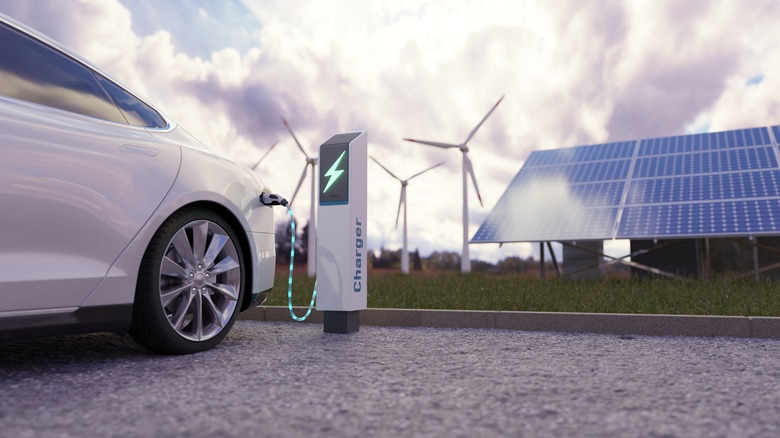How Many Solar Panels Are Needed To Charge A Tesla?
Many Tesla owners install a home charging station, which might cost more than they think, to keep their vehicles charged and ready to go every morning — as opposed to using a public charging station. However, these stations are typically connected to the house via traditional means.
What if the house utilizes solar power, though? Solar energy has grown in popularity over the last decade as a means to provide clean, sustainable power to the house. In many states, a homeowner can save a lot on their energy bill if they have enough solar panels to power their house.
Since they don't use energy from the grid, they receive credits from their local power company for the power their solar array produces. As Tesla sells millions of cars each year, there's bound to be some overlap between solar and Tesla owners. Can an alternative energy source efficiently power a Tesla? More importantly, how many panels would it take to charge a Tesla overnight?
Things to consider
There are many factors to consider when using solar power to charge a Tesla. For starters, the solar panel's power rating greatly affects how many a homeowner should install. Most residential solar panels have a power output rating of 250 watts, but there are larger ones with a rating of up to 400 watts of power. Each individual panel generates between 1.2 to 1.5 kWh of electricity each day. Naturally, the amount of power a panel generates depends on its exposure to sunlight, with longer exposure producing more electricity.
Then there's the battery capacity and electricity usage of a Tesla to consider. Tesla manufactures five different vehicles — including the new Cybertruck — each varying in battery capacity and usage. Not to mention, each EV is capable of driving different maximum ranges. The Model Y, Tesla's most popular vehicle in 2023, comes in three different trims, each with a different battery capacity. Its Long Range model has a capacity of 81 kWh.
The Long Range model can drive an estimated 310 miles before needing a charge, which determines how many full charges the car needs in a month. Determining the number of charges a Tesla needs in a month is an important variable when determining how many solar panels are necessary to charge it. The last factor is how many miles a person drives in their Tesla.
Time to do some basic math
According to the U.S. Department of Transportation, in a 2022 study, the average American drives 13,476 miles every year. You can break that down with some basic math to determine how many miles that is for a month, and even for a day's worth of driving. With that calculation, the average American drives 1,123 miles in a month and a little more than 37 miles in a day.
Divide the Model Y's 310 mile range by 1,123 miles, and you find that it requires roughly four full charges in a month. 3.62, to be exact, but round up for a more definitive answer. Multiply that by the battery's capacity of 81 kWh, and you end up with 324 kWh required for the month. This can be broken down further to a daily requirement of 10.8 kWh. As stated earlier, one needs to consider a solar panel's exposure to the sun, because they don't receive direct sunlight all day, every day.
Divide the 10.8 kWh necessary for a day by five hours, a conservative estimate of sun exposure, to conclude that a single solar panel needs to produce 2.16 kW to meet energy needs. Since there is some energy lost during conversion — receiving roughly 78% of the energy output — divide by .78, and end up with 2.77 kW needed. Then, you can divide that by the power rating of your solar panels. 250 watts should be converted to .25 and 400 to .4 kW.
A rough estimate of solar panels
If you purchase and install 250-watt solar panels for your home, the basic formula of 2.77 kW divided by .25 gives you 11.08. This means you would need roughly 11 of those solar panels to charge your Tesla Model Y with the Long-Range battery. However, if you install 400-watt panels instead, you would only need seven. Of course, these equations have many variables because even one alteration changes everything. The conclusions vary even if you calculate the amount of time the sun is out differently.
The type of Tesla a person owns changes everything as well. Not every Tesla is designed equally, and they each have different maximum ranges they can drive, as well as differing battery capacities. Even a different Model Y will change the equation. The Model 3's two different trims, for example, contain a 50 and 70 kWh battery. It's important to remember that these equations only calculate the number of panels needed for a Tesla. That's on top of however many panels the rest of the house needs to receive sufficient power.
There are online calculators that simplify everything, such as the one at 8 Billion Trees, but it's unknown what it takes into account to come to its conclusions. However, if you don't trust your math skills, an online calculator is going to help greatly. There are a few common myths surrounding solar panels, but they're undoubtedly up to the task of charging any vehicle Tesla produces.



